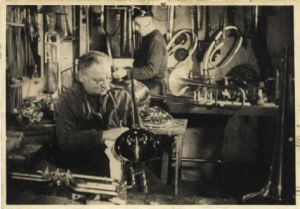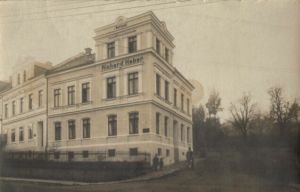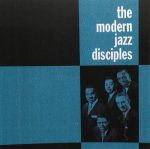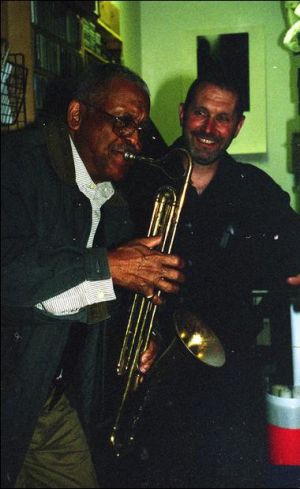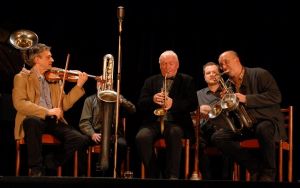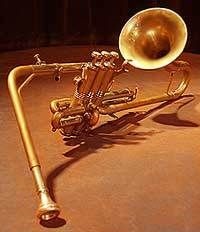Difference between revisions of "Normaphone"
Gwesterhof (talk | contribs) |
Gwesterhof (talk | contribs) |
||
| Line 1: | Line 1: | ||
| − | The Normaphone | + | =The Normaphone= |
The Normaphon was a saxophone shaped trumpet with only one bell, invented by Richard Oskar Heber (1872-1938) from Markneukirchen. Between 1900 and 1935 he produced brass instruments under the Norma-brand at the Schützenstrasse 36 in Markneukirchen. | The Normaphon was a saxophone shaped trumpet with only one bell, invented by Richard Oskar Heber (1872-1938) from Markneukirchen. Between 1900 and 1935 he produced brass instruments under the Norma-brand at the Schützenstrasse 36 in Markneukirchen. | ||
| − | + | [[File:Richard Oscar Heber1 .jpg|thumb|left|<small>Richard Oskar Heber at work</small>]] | |
| + | [[File:Schuetzenstrasse 36 Markneukirchen.jpg|thumb|left|<small>Schützenstrasse 36 Markneukirchen photo's copyright Ines Ann Heber</small>]] | ||
| − | + | Heber advertised the Normaphon as very appropriate for 'Jazz-Band und sonstige Effekt-Kapellen'. Roughly 100 Normaphons were built from approximately 1924/25 until 1930, and were distributed through wholesalers such as C.A. Wunderlich in Siebenbrunn, R.O. Adler, Johannes Adler and C.G Glier in Markneukirchen, Ammon Gläser in Erlbach and M. J. Kalashen in New York. The Gebrüder Schuster in Markneukirchen, 'Fabrik und Export von Musikinstrumenten und Saiten', from 1854, had the Normaphon in their [https://marge.home.xs4all.nl/Schuster%201925%20-%20207%20-%20Jazzband-Instrumente.jpg Katalog Nr. 70], (ca. 1929). Normaphons were sent out to musical directors all over the world to promote the new instrument. | |
| − | |||
| − | Heber advertised the Normaphon as very appropriate for 'Jazz-Band und sonstige Effekt-Kapellen'. Roughly 100 Normaphons were built from approximately 1924/25 until 1930, and were distributed through wholesalers such as C.A. Wunderlich in Siebenbrunn, R.O. Adler, Johannes Adler and C.G Glier in Markneukirchen, Ammon Gläser in Erlbach and M. J. Kalashen in New York. The Gebrüder Schuster in Markneukirchen, 'Fabrik und Export von Musikinstrumenten und Saiten', from 1854, had the Normaphon in their Katalog Nr. 70, (ca. 1929). Normaphons were sent out to musical directors all over the world to promote the new instrument. | ||
The Normaphon also had a D.R.G.M-registration from 26.02.1926, number 51c. 945 751, under the name 'Metallblasinstrument', on Richard Hebers name. | The Normaphon also had a D.R.G.M-registration from 26.02.1926, number 51c. 945 751, under the name 'Metallblasinstrument', on Richard Hebers name. | ||
| − | The C.G.Glier catalog from October 1926 states that patents are claimed both at home and abroad. There were four sizes of the instrument (specials possible), but most of them were build in tenor. Albert Rice explains that they were build not only with piston but also with rotary valves. The National Music Museum in Vermillion SD owns the only known rotary valve example. The soprano also had a version with an echo effect-valve, similar to the Jazzophon. Initially, there also was a choice between high and low pitch. | + | The [https://marge.home.xs4all.nl/Max%20Adler%20Normaphon.JPG C.G.Glier catalog] from October 1926 states that patents are claimed both at home and abroad. There were four sizes of the instrument (specials possible), but most of them were build in tenor. Albert Rice explains that they were build not only with piston but also with rotary valves. The National Music Museum in Vermillion SD owns the only known rotary valve example. The soprano also had a version with an echo effect-valve, similar to the Jazzophon. Initially, there also was a choice between [https://marge.home.xs4all.nl/Katalog%20Normaphon.jpg high and low pitch]. |
Max Adler from Erlbach offered in his catalogue number 25 also the English high pitch and the Normaphon in C and in F for the same price. Adler advertises the Normaphon as a solo instrument. | Max Adler from Erlbach offered in his catalogue number 25 also the English high pitch and the Normaphon in C and in F for the same price. Adler advertises the Normaphon as a solo instrument. | ||
| Line 17: | Line 16: | ||
Remarkable: C.A. Wunderlich offered around 1928 also a soprano version of the Normaphon with an echo effect valve, a kind of Jazzophon in fact. The New Langwill Index states that C.A. Wunderlich held the Normaphon patent, that could be a misinterpretation or Wunderlich must have acquired it from Heber. | Remarkable: C.A. Wunderlich offered around 1928 also a soprano version of the Normaphon with an echo effect valve, a kind of Jazzophon in fact. The New Langwill Index states that C.A. Wunderlich held the Normaphon patent, that could be a misinterpretation or Wunderlich must have acquired it from Heber. | ||
| − | In or after 1931 Robert Oswald Adler still (and only) offered the sopran, alto and tenor Normaphon, as did Johannes Adler in his Liste 31. The 1934 C.A.Wunderlich catalog shows no Normaphons nor Jazzophons anymore. | + | In or after 1931 Robert Oswald Adler still (and only) offered the [https://marge.home.xs4all.nl/R%20O%20Adler%20Normaphon.JPG sopran], alto and tenor Normaphon, as did Johannes Adler in his Liste 31. The 1934 C.A.Wunderlich catalog shows no Normaphons nor Jazzophons anymore. |
| + | [[File:NMM 1526 Normaphon 0200 rotary.jpg|thumb|left|<small>Normaphon with rotary valves, serial number 0200, coll. NMM</small> | ||
| − | + | The [https://www.usd.edu/fine-arts/national-music-museum National Music Museum of the University of South Dakota] has a soprano and two tenor Normaphons, one of them having rotary valves. This last one (serial number 0200), the only example with the usual Normaphon D.R.G.M. Germany engraving with rotary valves known so far, has no distributor name engraved. | |
| − | |||
| − | |||
| − | |||
| − | + | Pieter Aafjes, from 1907 - 1947 musical director of Crescendo, a concert band in Culemborg, the Netherlands, obtained an alto Normaphon from C.A. Wunderlich with serial number 0104, to give it a try. Through Riet van Dillen, the daughter of his successor Jac van Dillen, it came in my possession. | |
| − | + | <gallery widths="150" heights="150"> | |
| + | File:Normafoon Riet van Dillen Es (2) kl.jpg | ||
| + | File:Normafoon Riet van Dillen Es (4) kl.jpg | ||
| + | File:Normafoon Riet van Dillen Es (5) kl.jpg | ||
| + | File:Normafoon Riet van Dillen Es (6) kl.jpg | ||
| + | </gallery> | ||
| − | + | <small>Alto Normaphon in Eb, originally nickel plated, serial number 0104. On the bell: C.A. Wunderlich Siebenbrunn Vogtl. coll. Gerard Westerhof</small> | |
| − | |||
| − | |||
| − | |||
| − | Alto Normaphon in Eb, originally nickel plated, serial number 0104. On the bell: C.A. Wunderlich Siebenbrunn Vogtl. coll. Gerard Westerhof | ||
| − | Normaphones can be found amongst others at the Edinburgh University Collection of Historic Musical Instruments, the MIM in Phoenix, the Museum of Musical Instruments of the Leipzig University, the HJM Brass Collection in Turku, Finland and the Trompetenmuseum in Bad Säckingen (that has a tenor from Schuster & Co.). | + | Normaphones can be found amongst others at the Edinburgh University Collection of Historic Musical Instruments, the [https://themim.org/ MIM] in Phoenix, the Museum of Musical Instruments of the Leipzig University, [http://www.hjmbrasscollection.com/ the HJM Brass Collection] in Turku, Finland and the [http://www.trompetenmuseum.de/ Trompetenmuseum] in Bad Säckingen (that has a tenor from Schuster & Co.). |
| − | In 1956 Karl Linsenmeijer, then 16 years old, entered the Musikverein Offnadingen (a small village near Freiburg, Germany) and played an alto Normaphon untill he changed to clarinet in 1965. He played it together with Karl Schleer, who changed to flugelhorn. The Musikverein had severe losses during WWII, having only 5 active members left in 1945. The Normaphon was bought because at the time the money was very tight and sometimes even two musicians had only one instrument, so Jürgen Schleer, now chairman and son of Karl. Where it was bought is not known, after 1965 it went to a music store. In the orchestra the Normaphon was counted as a flugelhorn, the notes were always rewritten by the conductor, mostly from the tenor horn. "The exotic Normaphon has always been a highlight and an eye-catcher at every party and every performance', says Jürgen. | + | In 1956 Karl Linsenmeijer, then 16 years old, entered the [http://www.musikverein-offnadingen.de/wp-content/uploads/2017/09/OMZ-13-2015.pdf Musikverein Offnadingen] (a small village near Freiburg, Germany) and played an alto Normaphon untill he changed to clarinet in 1965. He played it together with Karl Schleer, who changed to flugelhorn. The Musikverein had severe losses during WWII, having only 5 active members left in 1945. The Normaphon was bought because at the time the money was very tight and sometimes even two musicians had only one instrument, so Jürgen Schleer, now chairman and son of Karl. Where it was bought is not known, after 1965 it went to a music store. In the orchestra the Normaphon was counted as a flugelhorn, the notes were always rewritten by the conductor, mostly from the tenor horn. "The exotic Normaphon has always been a highlight and an eye-catcher at every party and every performance', says Jürgen. |
In 1957 Nat King Cole performed 'Rosetta' in one of his shows together with Billy Eckstine (8 July 1914 – 8 March 1993), Eckstine playing a tenor Normaphone (from 2.12"). | In 1957 Nat King Cole performed 'Rosetta' in one of his shows together with Billy Eckstine (8 July 1914 – 8 March 1993), Eckstine playing a tenor Normaphone (from 2.12"). | ||
| − | + | <gallery widths="150" heights="150"> | |
| + | File:William Kelley.jpg|<small>William 'Hicky' Kelley</small> | ||
| + | File:Modern jazz disciples1.jpg|<small>MJD, left: William Kelley</small> | ||
| + | </gallery> | ||
| − | William 'Hicky' Kelley played a Normaphone (probably an alto) in 1959 and 1960 with the Modern Jazz Disciples on two records, 'The modern jazz disciples' and 'right down front'. Kelley (March 12, 1929 Cincinnati - May 9, 1998 Cincinnati) started his musical career on the trumpet and later picked up the Normaphone. The notes to the original first album of the Modern Jazz Disciples state that Kelley would like it made clear that that his use of the Normaphon (and the euphonium on one track) is "not one of novelty. He is dedicated to their use as jazz pieces. He has no desire to become an 'avant-courier' for them in the field of jazz." Here's Kelley on the Normaphone in Disciples Blues (as of 4.50") (and here's more about this piece). | + | William 'Hicky' Kelley played a Normaphone (probably an alto) in 1959 and 1960 with the Modern Jazz Disciples on two records, 'The modern jazz disciples' and 'right down front'. Kelley (March 12, 1929 Cincinnati - May 9, 1998 Cincinnati) started his musical career on the trumpet and later picked up the Normaphone. The notes to the original first album of the Modern Jazz Disciples state that Kelley would like it made clear that that his use of the Normaphon (and the euphonium on one track) is "not one of novelty. He is dedicated to their use as jazz pieces. He has no desire to become an 'avant-courier' for them in the field of jazz." [https://www.youtube.com/watch?v=mAbJ-lKw77U Here]'s Kelley on the Normaphone in Disciples Blues (as of 4.50") (and [http://www.milofultzmusic.com/blog/2015/1/18/lead-sheet-of-disciples-blues here]'s more about this piece). |
Multi instrumentalist Scott Robinson from Teaneck, New Jersey, played a tenor Normaphon on his first LP Multiple Instruments from 1984 and in later years with Hazmat Modine on their CD Bahamut. | Multi instrumentalist Scott Robinson from Teaneck, New Jersey, played a tenor Normaphon on his first LP Multiple Instruments from 1984 and in later years with Hazmat Modine on their CD Bahamut. | ||
| − | + | And yet another multi instrumentalist, Eric Budd from Melbourne, Australia showing his tenor Normaphon (serial number 0164).</small>]] | |
| − | And yet another multi instrumentalist, Eric Budd from Melbourne, Australia showing his tenor Normaphon (serial number 0164). | ||
Tom Guralnick has a tenor Normaphon (serial number 0238) that he got from Bob Klein in New York around 2001. Bob's father played in the NY Philharmonic and taught in a community music school where he discovered it some 50 years ago when he closed down the music school, and Bob gave it to Tom some 15 years ago. Tom is the director at Outpost, Albuquerque, and occasionally shows the instrument to guest musicians. 'Rosewell Rudd dug it". Here's jazz trumpeter Bobby Bradford (1934) trying, with Tom looking. | Tom Guralnick has a tenor Normaphon (serial number 0238) that he got from Bob Klein in New York around 2001. Bob's father played in the NY Philharmonic and taught in a community music school where he discovered it some 50 years ago when he closed down the music school, and Bob gave it to Tom some 15 years ago. Tom is the director at Outpost, Albuquerque, and occasionally shows the instrument to guest musicians. 'Rosewell Rudd dug it". Here's jazz trumpeter Bobby Bradford (1934) trying, with Tom looking. | ||
| − | + | [[File:Bobby Bradford with Tom Guralnick looking, 12 april 2004 Outpost Albuquerque.jpg|thumb|left|<small>Bobby Bradford and Tom Guralnick 12 april 2004, photo Mark Weber</small>]] | |
| − | |||
| − | |||
| − | Bob Zajíček Kvintet | + | [[File:2013 12 18 Happy New Year Bob Zajicek 1.jpg|thumb|left|<small>Bob Zajíček Kvintet</small>]] [[File:Jazzofon coll Bob Zajicek.jpg|thumb|left|<small>Soprano Normaphon coll. B.Zajíček</small>]] |
| − | Legendary Prague trumpeter and cornettist Luboš 'Bob Zajíček (6-10-1938) and his quintet performed on December 18th, 2013 at ...., with Bob (center) on a soprano Normaphone, ... on Violinophone and .. on a Jazzophone, probably pitched in Eb. Bob Zajíček also hosts a programm called JAZZOFON on radio station Vltava. Zajíček and his friends, playing what's now called traditional jazz, are keeping alive a tradition of which the Jazzophon is the ultimate icon. | + | Legendary Prague trumpeter and cornettist Luboš 'Bob Zajíček (6-10-1938) and his quintet performed on December 18th, 2013 at ...., with Bob (center) on a soprano Normaphone, ... on Violinophone and .. on a Jazzophone, probably pitched in Eb. Bob Zajíček also hosts a programm called [https://vltava.rozhlas.cz/jazzofon-5057400 JAZZOFON] on radio station Vltava. Zajíček and his friends, playing what's now called traditional jazz, are keeping alive a tradition of which the Jazzophon is the ultimate icon. |
Revision as of 21:57, 30 May 2019
The Normaphone
The Normaphon was a saxophone shaped trumpet with only one bell, invented by Richard Oskar Heber (1872-1938) from Markneukirchen. Between 1900 and 1935 he produced brass instruments under the Norma-brand at the Schützenstrasse 36 in Markneukirchen.
Heber advertised the Normaphon as very appropriate for 'Jazz-Band und sonstige Effekt-Kapellen'. Roughly 100 Normaphons were built from approximately 1924/25 until 1930, and were distributed through wholesalers such as C.A. Wunderlich in Siebenbrunn, R.O. Adler, Johannes Adler and C.G Glier in Markneukirchen, Ammon Gläser in Erlbach and M. J. Kalashen in New York. The Gebrüder Schuster in Markneukirchen, 'Fabrik und Export von Musikinstrumenten und Saiten', from 1854, had the Normaphon in their Katalog Nr. 70, (ca. 1929). Normaphons were sent out to musical directors all over the world to promote the new instrument.
The Normaphon also had a D.R.G.M-registration from 26.02.1926, number 51c. 945 751, under the name 'Metallblasinstrument', on Richard Hebers name.
The C.G.Glier catalog from October 1926 states that patents are claimed both at home and abroad. There were four sizes of the instrument (specials possible), but most of them were build in tenor. Albert Rice explains that they were build not only with piston but also with rotary valves. The National Music Museum in Vermillion SD owns the only known rotary valve example. The soprano also had a version with an echo effect-valve, similar to the Jazzophon. Initially, there also was a choice between high and low pitch.
Max Adler from Erlbach offered in his catalogue number 25 also the English high pitch and the Normaphon in C and in F for the same price. Adler advertises the Normaphon as a solo instrument.
Remarkable: C.A. Wunderlich offered around 1928 also a soprano version of the Normaphon with an echo effect valve, a kind of Jazzophon in fact. The New Langwill Index states that C.A. Wunderlich held the Normaphon patent, that could be a misinterpretation or Wunderlich must have acquired it from Heber.
In or after 1931 Robert Oswald Adler still (and only) offered the sopran, alto and tenor Normaphon, as did Johannes Adler in his Liste 31. The 1934 C.A.Wunderlich catalog shows no Normaphons nor Jazzophons anymore.

Tom Guralnick has a tenor Normaphon (serial number 0238) that he got from Bob Klein in New York around 2001. Bob's father played in the NY Philharmonic and taught in a community music school where he discovered it some 50 years ago when he closed down the music school, and Bob gave it to Tom some 15 years ago. Tom is the director at Outpost, Albuquerque, and occasionally shows the instrument to guest musicians. 'Rosewell Rudd dug it". Here's jazz trumpeter Bobby Bradford (1934) trying, with Tom looking.
Legendary Prague trumpeter and cornettist Luboš 'Bob Zajíček (6-10-1938) and his quintet performed on December 18th, 2013 at ...., with Bob (center) on a soprano Normaphone, ... on Violinophone and .. on a Jazzophone, probably pitched in Eb. Bob Zajíček also hosts a programm called JAZZOFON on radio station Vltava. Zajíček and his friends, playing what's now called traditional jazz, are keeping alive a tradition of which the Jazzophon is the ultimate icon.
In the 1930s jazz in Germany began to see its downturn. Despite the liberal attitudes of the Weimar democracy, the public and private sentiment toward blacks, including African Americans, was an ambivalent. In 1932, all the conservative musicians and critics were denigrating jazz as a product of 'nigger' culture, which provided the government the fodder to forbid hiring of colored musicians. One critic even went so far as to call jazz a mere 'nigger noise', having only one purpose: "to introduce obscenities into society."
For the Nazis, jazz was a threatening form of expression and the saxophone was jazz. The Nazi regime pursued and banned the broadcasting of jazz on German radio, partly because of its African roots and because many of the active jazz musicians were of Jewish origin; and partly due to the music's certain themes of individuality and freedom. The jazz studies in Frankfurt were closed by the Nazis in 1933. Joseph Goebbels, the Reich Minister of Public Enlightenment and Propaganda, had hoped to convince and persuade the public via anti-jazz propaganda before 1935, rather than prohibit jazz. However, jazz was officially banned in 1935. In 1935, the Nazi government did not allow German musicians of Jewish origin to perform any longer. Listening to foreign stations, which regularly played jazz, was penalized from 1939 on.
Poster for an Exhibition in Dusseldorf, 1938
The saxophone - so strongly associated with jazz - was seen in Germany as the anti-German instrument, proposes Günther Dullat in his book on nearly forgotten wind instruments. Although that didn't imply that saxophone production in Germany came to an end. In 1938/1939 C.A. Wunderlich still sold saxophones, engraved with with a swastika and an eagle, used by the German Luftwaffe. And in 1939 Ernst Hess Nachf. from Klingenthal offers on the last page of his catalog offers a Saxie, a little saxophone-like instrument, because "how often do small village bands not like having a saxophone". In the same catalog Hess proudly announces their making the new Herms-Niels fanfares with which the glory of Hitler was praised at the Reichsparteitag in 1938.
Eventually though, not many Jazzophons and Normaphons were built. Despite the beautiful names they were a failure, and soon they disappeared from the market, to become a collector's item, stated collector Ernst W. Buser. Some 25 Jazzophons are known to be extant.
It's not sure however, whether the declining appreciation of jazz in Germany was the reason, or the only reason, for Jazzophons not becoming a big hit. It seems likely that the failure of the Jazzophon has more to do with a mismatch between supply and demand, even before the Nazis came to power. "It May Look Like a Musical Instrument, but It's Really an Edsel," wrote the New York Times in 2005, in an article in which the Jazzophon figured among other musical instruments that were unsuccessful. The Edsel is the Ford Edsel, in the late fifties the example of a commercial failure. And then there was the global crisis of the late twenties, which gave saxophone sales worldwide a major blow. From 1929 to 1932 exportsales of the German musical instrument business decreased from 100,52 to 22,66 millions of Reichsmarks, less than a quarter of the Golden Twenties. And in the end, they were a little difficult to play as well. The form is unfavorable for the trumpet embouchure, and, as Heribert Schröder states, simply using a mute might be cheaper and more appealing to the audience then buying a newly designed trumpet.
